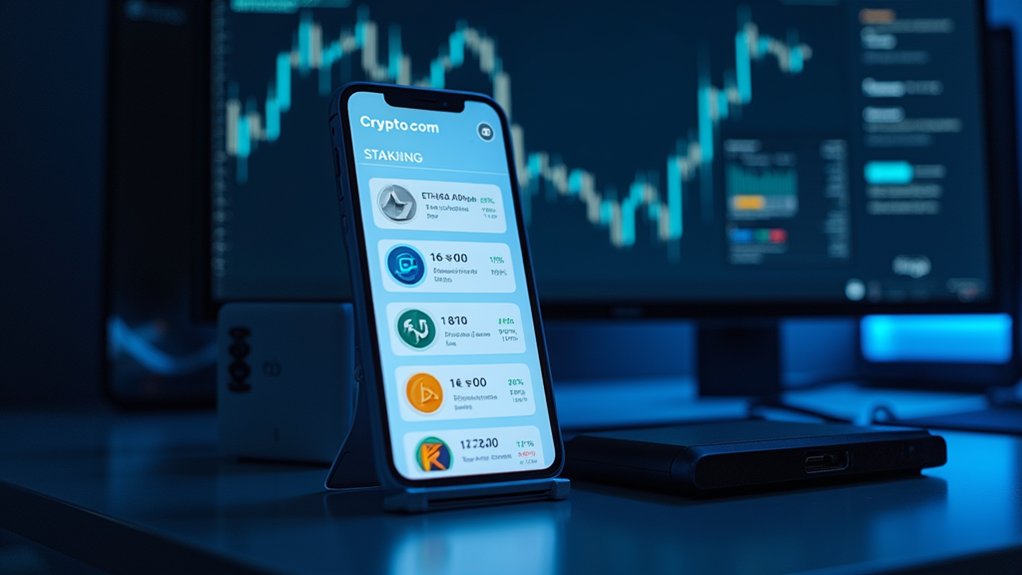To stake on Crypto.com, users must navigate to the dedicated staking section within the mobile app or exchange platform, select their preferred digital asset (like ADA, ETH, or SOL), specify their investment amount, and confirm the transaction. Assets shift through verification phases before generating rewards, which are distributed up to three times weekly after deducting service fees (typically 20%, though NEAR and INJ incur 35%). The complete staking process involves essential status shifts and unbonding periods that merit further examination.

Many cryptocurrency investors are turning to staking in the capacity of a method of generating passive income while contributing to blockchain network security. Through Proof-of-Stake (PoS) protocols, participants can validate transactions and secure networks by locking their digital assets, thereby earning rewards proportionate to their staked amounts. This process has gained considerable traction as energy-efficient alternatives to mining emerge across the blockchain ecosystem.
Stake your crypto assets to earn passive rewards while bolstering network security in the eco-friendly blockchain economy.
The staking process on Crypto.com follows a structured workflow that allows users to participate with minimal complexity. Interested parties may access staking functionalities via both the mobile application and exchange platform, where they can navigate to the dedicated staking section through the menu. They can select their desired asset from a diverse portfolio including ADA, ETH, SOL, DOT, ATOM, and NEAR, specify their intended stake amount, and confirm the transaction using their established security measures such as passcode or biometric identification.
Upon submission, staked assets progress through several status phases that reflect their on-chain position. Initially, assets enter a Pending status as the platform verifies balance sufficiency and blocks the designated amount from trading or withdrawal. Subsequently, assets shift to Activating status when the blockchain commitment process begins, with the duration varying greatly based on protocol-specific epoch cycles, such as Ethereum's 6.4-minute epochs or other networks' timing structures.
Crypto.com implements a fee structure that varies by asset, with most tokens incurring a 20% service fee on rewards, while others such as NEAR and INJ command a higher 35% fee. These fees are automatically deducted, with displayed rewards reflecting net earnings after the platform's commissions have been extracted. Reward distributions occur up to three times weekly, contingent upon the foundational blockchain's epoch system and validator performance metrics.
For users experiencing rejection due to insufficient funds or regulatory restrictions, resubmission may be necessary following balance adjustment or compliance resolution. Throughout the staking period, assets remain locked in the Staked status, generating rewards while being unavailable for trading or transfer operations until the predetermined unbonding period concludes.
Frequently Asked Questions
What Are the Tax Implications of Staking on Crypto.Com?
Staking rewards on Crypto.com generate taxable income upon receipt, following the dominion and control principle despite platform location.
Investors must report rewards at fair market value in USD when received, documenting these transactions on Form 1040 Schedule 1 in the capacity of "Other Income."
The cost basis of staked assets adjusts to include both original investment and declared income, while subsequent sales trigger capital gains events reportable on Schedule D using Schedule 8949.
Can I Stake if I'm in a Restricted Country?
Users residing in restricted jurisdictions cannot participate in staking activities on Crypto.com, regardless of verification status.
The platform employs geographical restrictions that vary by staking type, with on-chain staking prohibited in Canada, Hong Kong, South Korea, Thailand, and specific U.S. states.
Meanwhile, liquid staking excludes Australia, Kazakhstan, Malta, and sanctioned nations.
Should users relocate to restricted areas following initiating staking, rewards accrual ceases immediately, though staked assets remain locked until the unstaking period concludes.
What Happens to My Stake During Market Crashes?
During market crashes, staked assets remain locked for the predetermined period, preventing liquidation or reallocation despite declining values.
This illiquidity exposes investors to heightened downside risk, particularly with tokens like CRO which have demonstrated significant volatility (-27.4% weekly) during previous reward adjustment controversies.
Additionally, platforms may reduce staking rewards during downturns, since evidenced by Crypto.com's prior reduction to 0% for lower-tier offerings, citing "long-term sustainability" while facing substantial user backlash.
How Does Crypto.Com Staking Compare to Other Platforms?
Crypto.com's staking platform offers modest diversity with 21+ supported assets compared to Binance (60+) and KuCoin (350+).
While providing competitive yields of up to 15.47% for Solana and 5.5% for Ethereum, the platform distinguishes itself through a structured rewards system based on staking duration and CRO token holdings.
Its weekly reward distribution schedule contrasts with competitors offering daily payouts, potentially limiting liquidity options for investors seeking more frequent compounding opportunities.
Can I Add More Crypto to an Existing Stake?
Users can add additional funds to existing stakes via Crypto.com's in-app staking interface by selecting the same asset.
The platform processes new stakes independently while existing stakes remain active, subject to protocol-specific validation cycles before earning rewards.
Multiple stakes of identical assets are tracked separately within the portfolio section, with each new contribution requiring its own activation period before shifting from "Pending" through "Activating" to "Staked" status, at which point reward accrual begins.









